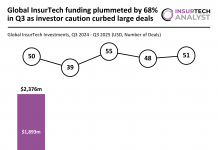When analysts begin working in pricing, their first instinct is often to dive straight into modelling. Generalised Linear Models (GLMs) are a standard approach, commonly taught as the foundation for pricing models. It is easy to get caught up in testing different variables, applying transformations, and searching for interactions. However, focusing solely on model mechanics can cause analysts to overlook fundamental limitations, according to Quantee.
GLMs operate under two key assumptions that are not always valid in real-world scenarios:
- Data has full credibility.
- Randomness of outcomes is uncorrelated.
This article explores these limitations and discusses how actuarial expertise can help address them.
The assumption of full credibility in data
GLMs assume that all data is fully credible, meaning that estimates are considered entirely reliable, regardless of the sample size. This can be problematic when working with limited data.
For example, consider an insurance pricing model estimating the severity of claims in different Mexican cities.
A basic model using only the city as a predictor will estimate the expected average severity per location. Large cities like Mexico City (CDMX), Guadalajara, and Monterrey have thousands of claims, making their estimates more reliable. However, a smaller city like San Cristóbal de las Casas may have only 120 claims, where a single high-cost claim could significantly distort the average. The GLM does not adjust for this—it treats all data as equally credible.
To address this, actuaries can apply credibility weighting techniques such as Bühlmann Credibility:
Where:
- is the adjusted severity for a city.
- is the observed severity for the city.
- is the overall expected severity.
- is the credibility factor, determining how much weight to assign to individual city data versus the overall average.
If a city has many claims, its estimate relies more on its own data (higher ). If it has few claims, the estimate shifts towards the overall average (lower ).
Applying this to San Cristóbal de las Casas with a credibility factor of :
This method smooths estimates, reducing the impact of small sample sizes. Other approaches, such as Generalised Linear Mixed Models (GLMMs) and regularisation techniques, can further refine credibility adjustments.
The assumption of uncorrelated randomness
GLMs also assume that each record in a dataset exists in isolation, with no inherent relationships between observations. This assumption often fails in practice.
Consider auto insurance policy renewals. A dataset tracking customers across multiple years will treat each year as an independent record. However, a driver with an accident in Year 1 is likely to exhibit similar driving behaviour in subsequent years. The GLM does not recognise this continuity and may overestimate accident frequency by treating repeated incidents as separate events.
Similarly, when modelling insurance claims in Mexico, a hurricane striking Cancun may lead to numerous vehicle damage claims. The GLM views these as independent events, failing to account for their shared cause, which could result in overestimating future claims.
To correct for this, actuaries can use:
- GLMMs to tag related records (e.g., linking multiple years to the same policyholder).
- Generalised Estimating Equations (GEE) to adjust for correlated data.
- Aggregated data analysis to capture long-term trends rather than treating each record separately.
Should actuaries stop using GLMs?
The short answer is no. GLMs remain a fundamental tool in insurance pricing and continue to deliver reliable results when used correctly. However, actuaries play a crucial role in interpreting outcomes, identifying biases, and ensuring models reflect real-world dynamics.
Rather than relying on GLMs in isolation, insurers can enhance their predictive accuracy by integrating expert judgment and advanced statistical techniques. Exploring hybrid approaches that combine actuarial expertise with machine learning can further improve pricing strategies, leading to more robust and accurate models.
GLMs are not obsolete, but they require careful supervision. Actuaries must remain open to innovation while ensuring their models accurately capture business realities.
Read the full blog from Quantee here.










